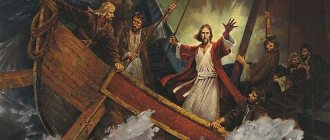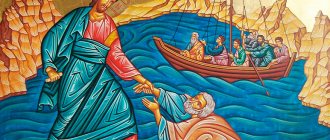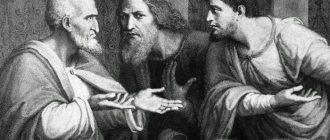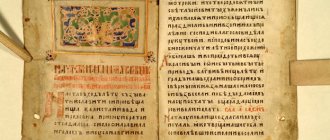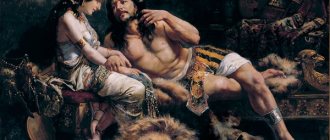The first book of the New Testament is the Gospel of Matthew. It is also considered the first among the four Gospels that are canonical. Some scholars place it second only to Mark. However, there is no doubt that it was written before similar works by Luke and John. The time of writing has not been reliably established; traditionally the book dates back to 41-55. Since the 18th century, most theologians have adhered to the period between 70-80. The content, composition, and interpretation of the Gospel of Matthew will be discussed in the article.
Essence and composition
The main theme of the Gospel of Matthew is the story of Jesus Christ, the Son of God, his life and preaching. The peculiarity of the book is that it is intended for a Jewish audience. It contains many references to Old Testament prophecies about the Messiah and seeks to show that these prophecies were fulfilled in Jesus Christ.
The beginning of the book is an indication of the genealogy of Jesus, going in an ascending line, starting from Abraham and ending with Joseph the Betrothed, called the husband of the Virgin Mary. Chapters five to seven give the most complete content of the Sermon on the Mount, which includes the quintessence of all Christian teaching, including the Beatitudes and the Lord’s Prayer.
The speeches and deeds of the Savior are given in three parts, which correspond to the three hypostases of the Messiah's ministry as:
- Prophet and Lawgiver.
- The king placed over the visible and invisible worlds.
- The High Priest who sacrifices himself to atone for the sins of all people.
The Capture of Jesus in the Garden of Gethsemane
A little time passed and the people at Calvary spat in His face.
(John 18:5,6) In the garden the Pharisees ordered Him to be bound, and we know that no one could bind Jesus without His consent.
They said: We are looking for Jesus of Nazareth.
He told them: I Am
I Am is the Name of God spoken in the burning bush to Moses. And they stepped back and fell to the ground, they were pinned to the ground. Jesus allowed them to stand up, recover, and arrest Him. He gave Himself voluntarily into their hands; He was not captured. He gave Himself for us.
And here was this terrible scene that the heavens looked upon. People spat in His face and beat Him.
The difference in parables
The Gospel of Matthew differs from others in that it is the only one that talks about the healing of a demon-possessed mute, two blind men, and the episode with a coin in the mouth of a fish.
Only here are parables about:
- tares;
- pearl of great price;
- cruel lender;
- workers in the vineyard;
- treasure in the field;
- two sons;
- wedding feast;
- ten virgins;
- talents
Who is author?
According to ancient church tradition, the author of one of the four Gospels is the Apostle Matthew, who was a tax collector and followed Jesus. Eusebius of Caesarea, a church historian who lived in the 4th century, wrote in his explanations of the Gospel of Matthew that he first preached to the Jews, and then to representatives of other nations, handing them his scripture in Hebrew. It was subsequently translated into other languages.
One of the church teachers of the 4th-5th centuries, Saint Jerome of Stridon, claimed that he saw the original Gospel of Matthew written in Hebrew. It was in the Caesarea Library, which was collected by the martyr Pamphilus.
The text of the Gospel does not contain any references to the identity of the author. Therefore, many modern researchers think that the Gospel of Matthew was not written by an eyewitness, and therefore not by the Apostle Matthew, but by another author who is unknown. Today there is a hypothesis about two sources. The first is the Gospel of Mark, and the second is the so-called source Q.
This is a purported collection of the sayings of Christ. They, along with the Gospel of Mark, were taken as a source by the authors who wrote the Gospels of Luke and Matthew. The hypothesis about its existence was put forward in the 19th century. Scientists believe that the author was most likely a Jew who professed the Christian faith, and wrote his works for other Jewish Christians.
3.4.1 Know the general content of the Gospels of Mark, Matthew, Luke and John, be able to briefly talk about the evangelistsAll four Gospels (the word “Gospel” translated from Greek means “good news”) tell about the life and teaching of Christ the Savior, His miracles, suffering on the cross, death and burial, His glorious Resurrection from the dead and Ascension into heaven. Mutually complementing and clarifying each other, they represent a single whole book that does not have any contradictions or disagreements in the main and main things. The traditional symbol for the four Gospels is the chariot that the prophet Ezekiel saw at the river Chebar (1: 1-28) and which consisted of four creatures - a man, a lion, a calf and an eagle. These creatures, each individually, became symbols of the evangelists. Christian art since the fifth century depicts St. Matthew with a man or angel, St. Mark - with a lion, St. Luke - with the calf, St. John - with an eagle. The symbol of the Evangelist Matthew became a man because in his Gospel he especially emphasizes the human origin of the Lord Jesus Christ. Symbol of St. Mark is a lion, a royal animal, a symbol of power and strength, for St. Mark brings out in particular the royal omnipotence of the Lord, gives in his Gospel a strong, vivid impression of the miracles of Christ, thereby emphasizing the royal greatness of the Lord. In his Gospel, Jesus Christ is not the “son of David”, as in Matthew, but the Son of God, Lord and Ruler, King of the universe. Symbol of St. Luke – a calf (a calf as a sacrificial animal in the Old Testament). St. Luke speaks primarily of Christ as the great High Priest who offered Himself as a sacrifice for the sins of the world. The Orthodox Church compares St. John to an eagle, since St. John, with the special sublimity of his thoughts and even the very majesty of his style, soars high in the sky, like an eagle. Of the four Gospels, the content of the first three - Matthew, Mark and Luke - largely coincides, close to each other, both in the narrative material itself and in the form of presentation; The fourth Gospel of John in this regard stands apart, differing significantly from the first three, both in the material presented in it, and in the style itself, the form of presentation. In this regard, the first three Gospels are usually called “synoptic”, from the Greek word “synopsis”, which means “presentation in one general image”. But although the first three Gospels are very close to each other both in plan and in content, which can easily be located in the corresponding parallel tables, each of them, however, also has its own characteristics. Thus, if the entire content of the individual Gospels is determined at 100%, then in Matthew it turns out that 58% of the content is similar to the others and 42% is different from the others; for Mark – 93% similar and 7% different; in Luke - 41% similar and 59% different, in John - 8% similar and as much as 92% different. Similarities are noticed mainly in the rendering of the sayings of Christ the Savior, while differences are seen in the narrative part. When Matthew and Luke literally agree with each other in their Gospels, Mark always agrees with them; the similarity between Luke and Mark is much closer than between Luke and Matthew; when Mark has additional features, Luke usually has them too, which cannot be said about features found only in Matthew; and, finally, in those cases where Mark does not report anything, the Evangelist Luke often differs from Matthew. The Synoptic Gospels tell almost exclusively about the activities of the Lord Jesus Christ in Galilee, St. John is in Judea. Forecasters talk mainly about miracles, parables and external events in the life of the Lord, St. John discusses its deepest meaning and cites the Lord’s speeches about the most sublime objects of faith. The main difference between the weather forecasters and St. John - in the conversations of the Lord they conveyed. Among weather forecasters, these conversations are very simple, easily understandable, and popular; in John - they are deep, mysterious, often difficult to understand, as if they were intended not for the crowd, but for some closer circle of listeners. But this is so: the weather forecasters cite the speeches of the Lord addressed to the Galileans, simple and ignorant people, John conveys mainly the speeches of the Lord addressed to the Jews, scribes and Pharisees - people experienced in the knowledge of the Law of Moses, who stood more or less highly at the stages of education of that time. In addition, John had a special goal - to reveal as fully and deeply as possible the teaching about Jesus Christ as the Son of God, and this is a topic, of course, more difficult to understand than the parables of the weather forecasters, which are so understandable and easily understandable to everyone. In addition, the Gospel of John was written much later than the other three Gospels, at the end of the first century, around 96 after Christ, while the Temple of Jerusalem was destroyed by the Romans in 70. To better understand the Gospel, let us take a closer look at the personality and life of each of the four evangelists, and the circumstances under which each of the four Gospels was written.
1. Gospel of Matthew. Matthew was one of Christ's 12 apostles. Before being called to apostolic service, he was a publican, that is, a tax collector, and for this he was unloved by his Jewish compatriots, since publicans collected taxes for the Romans, the heterodox enslavers of the Jewish people. Touched to the depths of his soul by the mercy of the Lord, who called him immediately after the Savior performed the miracle of healing the paralytic (Matthew 9:9), despite the general contempt for him of the Jews and especially the spiritual leaders of the Jewish people - the scribes and Pharisees, Matthew wholeheartedly accepted the teaching of Christ and I especially deeply understood its superiority over the traditions and views of the Pharisees, which bore the stamp of only external righteousness, conceit and contempt for sinners. For the same reason, the evangelist took especially close to his heart the cause of saving his native Jewish people, and therefore his Gospel was written primarily for Jews. Matthew sets out to prove to them that Jesus Christ is exactly the Messiah about whom the Old Testament prophets predicted. Therefore, Matthew begins his Gospel with the genealogy of Jesus Christ, wanting to show the Jews His descent from David and Abraham, and makes a huge number of references to the Old Testament in order to prove the fulfillment of Old Testament prophecies on Him. The purpose of the first Gospel is also clear from the fact that St. Matthew, mentioning Jewish customs, does not explain their meaning and significance, as other evangelists do. Having written his Gospel for his Jewish compatriots (it is believed that in the 8th year after the Ascension of the Lord), St. Matthew preached for them in Palestine for a long time, but then he retired to preach in other countries and ended his life as a martyr in Ethiopia in the 60th year after the Nativity of Christ.
2. The Gospel of Mark. The Second Gospel was written by St. Mark, who also bore the name of John, was a Jew by origin, but was not one of the 12 apostles of the Lord, therefore he could not be such a constant companion and listener of the Savior as St. Matthew. He wrote his Gospel from the words and under the guidance of St. Apostle Peter. He himself, in all likelihood, was an eyewitness only to the last days of the Lord’s earthly life. Mark subsequently participates in the first journey of St. Apostle Paul to Perga (a city located on the southern coast of Asia Minor). According to legend, St. the Apostle Peter installed St. Mark as the first bishop of the Alexandrian Church. In Alexandria, the Apostle Mark baptized many residents of this city, which aroused the hatred of the pagans against him, and they decided to kill Saint Mark. Having learned about this, the holy apostle consecrated a bishop and ordained three presbyters. The pagans attacked Saint Mark while he was performing divine services. He was beaten and thrown into prison. The next day, the crowd dragged the holy Apostle through the streets of the city to the judgment seat, but on the way Saint Mark died with the words: “Into Your hands, Lord, I commend my spirit.” The pagans wanted to burn the body of the apostle. But when the fire was lit, everything went dark, thunder rang out and an earthquake occurred. The pagans fled in fear, and the Christians took the body of the holy apostle and buried it in a stone tomb. It was April 4, 1963. The Gospel of Mark is essentially a recording of the oral sermon of St. Apostle Peter, which St. Mark did this at the request of the Christians living in Rome. The very content of the second Gospel clearly indicates that it is intended for Gentile Christians. The pagans, unlike the Jews, were not familiar with the Old Testament, so St. Mark, unlike the Evangelist Matthew, says very little about the relationship of the Savior’s teaching to the Old Testament and very rarely provides references to the Old Testament holy books. Even the Sermon on the Mount, which explains the superiority of the New Testament canon over the Old Testament, is omitted. St. Mark, speaking about a city, often explains where this city is located. From this we can conclude that the apostle wrote his Gospel for people who were not familiar with the geography of Judea, Galilee and the surrounding areas, that is, not for the Jews. At the same time, we find Latin words in this Gospel, such as “speculator” (“squire”, 6:27), “centurio” (“centurion”, 15:44-45). Basically, the content of the Gospel of Mark is very close to the content of the Gospel of Matthew, but differs from it in greater brevity and conciseness.
3. Gospel of Luke. Who was the writer of the third Gospel of St. Luke, we don’t know exactly. It is generally accepted that St. Luke was a pagan by origin, who may have converted to Judaism. By occupation he was a doctor and a painter. According to legend, he painted the first icons of the Mother of God. Saint Luke also painted icons of the holy supreme apostles Peter and Paul. From the fact that his Gospel contains the Lord’s instructions to the 70 disciples, set out in great detail (Luke 10-1:16), they conclude that he belonged to the 70 disciples of Christ. From the book of the Acts of the Apostles it is clear that starting from the second journey of St. Apostle Paul, Luke becomes his constant collaborator and almost inseparable companion. There is information that after the death of St. Paul St. Luke preached and died a martyr's death in Achaia. St. Luke wrote his Gospel in the years 62-63 in Rome at the request of a certain noble man, Theophilus, who lived in Antioch, for whom he then wrote the book of the Acts of the Apostles. At the same time, he used the accounts of eyewitnesses and some written records that already existed then about the life and teaching of the Lord. These records and narratives were subjected to the most careful research, and therefore his Gospel is particularly accurate. Theophilus, for whom the Gospel was written, was not a resident of Palestine and had not been to Jerusalem, so Luke makes a lot of geographical explanations. The main idea of the Gospel of Luke is that the Messiah-Christ came to earth not only for the Jews, but also for the pagans, and is the Savior of the whole world, of all people. Therefore St. Luke brings the genealogy of Jesus Christ to the ancestor of all humanity, Adam, and to God Himself.
4. Gospel of John. The Fourth Gospel was written by Christ's beloved disciple St. John the Theologian. St. John was the son of the Galilean fisherman Zebedee and Salome. Zebedee was apparently a wealthy man, for he had workers and was not an insignificant member of Jewish society, for his son John had an acquaintance with the high priests. His mother Solomiya was the daughter of Joseph the betrothed, served the Lord and was one of the myrrh-bearing women. John was first a disciple of St. John the Baptist. Hearing his testimony about Christ, he and Andrew immediately followed Christ. He became a constant disciple of the Lord after a miraculous fishing trip on Lake Gennesaret, when the Lord himself called him along with his brother Jacob. Together with Peter and his brother Jacob, he was honored with special closeness to the Lord, being with Him in the most important and solemn moments of His earthly life. The Lord, being on the cross, entrusted His Most Pure Mother to John, saying to him: “Behold, your mother” (19:27). After the Ascension of the Lord we often see St. John together with St. the apostle Peter. Since the destruction of Jerusalem (70th year after R.H.), the place of life and work of St. John is made in Ephesus in Asia Minor. King Trajan for his preaching to St. John was exiled in prison to the island of Patmos. While there, he wrote his Gospel. After the death of Trajan, blessed John returned from the island, settled in Ephesus and lived to be 120 years old, where he died of his own death, according to legend, a very mysterious one (John 21:23: “And the word spread among the brothers that that disciple would not die. But Jesus did not tell him that he would not die, but: if I want him to remain until I come, what is that to you? The fourth Gospel was written by John at the request of the Ephesian Christians or even the Moloasian bishops. The purpose of writing the fourth Gospel was to complement the narrative of the first three evangelists. While the first three evangelists often narrate the same events and quote the same words of the Lord, John's Gospel is very different from them in its content, containing narrations of events and citing the speeches of the Lord, of which there is often no mention in the first three Gospels. The Gospel of John in ancient times was called the “Spiritual Gospel”, since it begins with the teaching about the Divinity of the Savior, and then contains a whole series of the most sublime speeches of the Lord, in which His Divine dignity and the deepest mysteries of faith are revealed. No one revealed as fully, deeply and convincingly as John in his Gospel and in his three conciliar epistles of the Christian teaching about the two main commandments of the Law of God - about love for God and about love for neighbor - which is why St. John is also called the “apostle of love.”
- 3.4.1.1. indicate places in the New Testament that speak of the prediction of the coming of the Savior; 3.4.1.2. talk about the earthly life of the Savior and the twelve feasts, the passion of the Lord and the Holy Resurrection; 3.4.1.3. talk about the calling of the apostles and know their names, or know the sources where they can be found; 3.4.1.4. talk about the miracles in Canna of Galilee, the resurrection of Lazarus; saturation with bread and casting out demons; 3.4.1.5. tell about two parables (to choose from): about the sower, about the rich man and Lazarus, about the prodigal son, about the publican and the Pharisee. 3.4.2. Have a general understanding of the Acts of the Apostles
Interpretation of the Gospel of Matthew
The Jewish people, to whom the Gospel was originally intended, had a fairly definite idea of the Messiah. The purpose of the Gospel was to convince readers that the major events that happened in the life of Christ were evidence of messianic prophecy. This is the Christological orientation of the book.
Christology is a section of theology in Christianity that includes the teaching about Jesus Christ, covering the following questions:
- Incarnation of the 2nd Person of the Holy Trinity - God the Son.
- The combination in Jesus of two natures at the same time, which are both divine and human.
- Associated with the life of the God-man.
After the descent of the Holy Spirit took place on the day of Pentecost, the disciples of Christ began to preach not only about God the Father, the Holy Spirit and the Son of God among the pagan population, but also about Jesus among the Jews. Thus, they laid the foundation for Christology not only as a practice, but also as one of the educational church disciplines. Soon a large number of texts appeared about Jesus of Nazareth, including the Gospel of Matthew.
Transfiguration
(Matthew 17:1-2) And at the end of six days Jesus took Peter, James, and John his brother, and led them up a high mountain alone, and was transfigured before them: and His face shone like the sun, and His clothes became white. like snow.
Transformation - metamorphosis.
Metamorphosis is the same word used when a caterpillar turns into a butterfly.
When you behold Jesus in His glory, you are transformed.
(2 Cor 3:14) But we all, with open face, beholding as in a mirror the glory of the Lord, are being transformed into the same image from glory to glory, even as by the Spirit of the Lord.
The more you look at Him, the more you are transformed from glory to glory into the same image.
And who does this? Are you through your own efforts?
Spirit of the Lord.
When you look at Jesus, at His beautiful, shining face, then all your earthly features dim.
(Hebrews 12:2) Looking to Jesus, the author and perfecter of our faith...
Behold—turn away from all distractions, focus on Him, and simply glorify Jesus Christ.
When you look at celebrities, you remain the same. When you look at Jesus, you are changed, you are transformed, His power is in this.
Continued interpretation
In addition to the Christological theme, the theological content of the book also includes a number of teachings that describe:
- The Kingdom of Heaven and the Church - the parables speak of the need to be ready to enter the Kingdom.
- The dignity of Kingdom servants in the world.
- Signs of the Kingdom and its growth in the souls of people.
- The revelation of the Kingdom during the Second Coming of Christ, as well as in the everyday spiritual life of the Church.
The Gospel of Matthew clearly expresses the idea that the Kingdom of Heaven and the Church have the closest connection with each other in Christian spiritual experience. The Church represents the embodiment of the Kingdom of Heaven in the world, and the Kingdom of Heaven is the Church in its cosmic embodiment.
Language of the book
If we agree with the testimony of the Church Fathers that the Gospel of Matthew is written in Hebrew, then this is the only book in the New Testament whose original was not written in Greek. Although in fact the Hebrew (Aramaic) original was not preserved, and a translation of the Gospel into ancient Greek was included in the canon.
Features of the book indicate that the author was a Jew from Palestine, since it contains a large number of phrases inherent in the Hebrew language. In addition, the author assumes that readers are familiar with the area and customs of the Jews.
The Gospel of Matthew, among other books included in the Bible, was first published in Russian at the beginning of the 19th century. There are also translations made in the 20th and 21st centuries.

